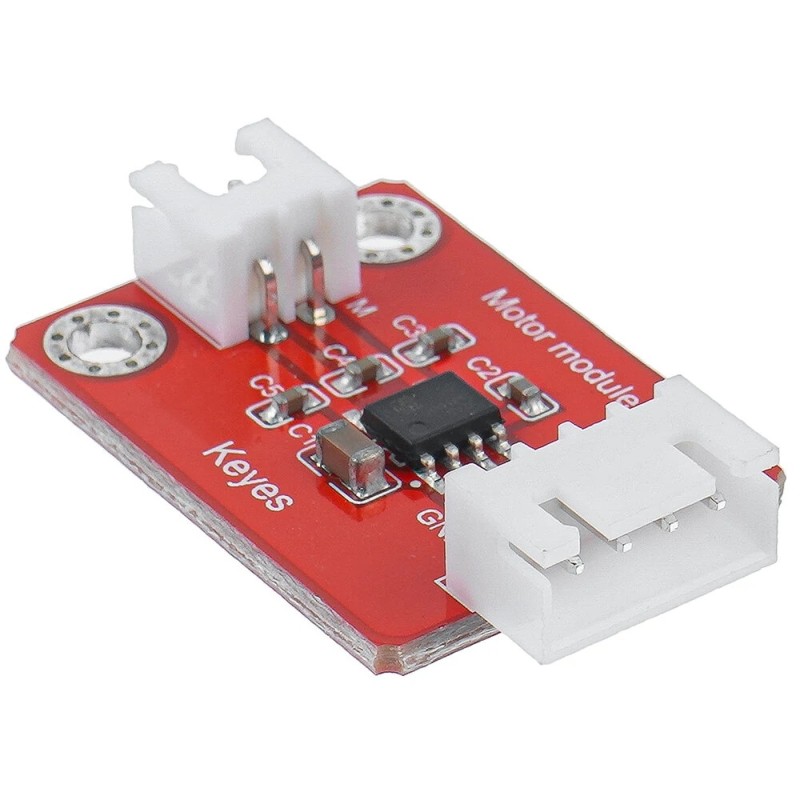

Module with the DC motor controller HR1124S. It allows you to control the movement of a DC motor with a voltage from 1.8 to 6.8 V and a current of up to 1.2 A. The board has an XH2.54 connector for connecting the motor and requires two PWM signals. It works well as a module for controlling motors from the 130 series.
Data sheet
Manufacturer BTC Korporacja sp. z o. o. Lwowska 5 05-120 Legionowo Poland sprzedaz@kamami.pl 22 767 36 20
Responsible person BTC Korporacja sp. z o. o. Lwowska 5 05-120 Legionowo Poland sprzedaz@kamami.pl 22 767 36 20
Brushed DC motor in a housing 130 supplied with a voltage ranging from 3 to 12 V, with a rotational speed of 11500 RPM and a current consumption of up to 800 mA. Pololu 1117
Brush DC motor with permanent magnets in housing 130
No product available!
Mini DC motor with permanent magnets with a rotation speed of up to 18,000 rpm. In a housing 130 with a 2 mm shaft
This compact breakout board is for ROHM’s BD65496MUV motor driver, which offers an operating voltage range of 2 V to 16 V and can deliver a continuous 1.2 A to a single brushed DC motor. Pololu 2960
Pololu Dual G2 High-Power Motor Driver 24v18 is an extension that allows you to control two DC motors designed for Raspberry Pi. The motors can be supplied with 6.5-36V voltage and can draw a maximum current of 18A. Pololu 3756
No product available!
Module with 2-channel driver for DC motors L298P. The board is equipped with a Grove connector and communicates via the I2C interface. Seeed Studio 105020093
TB6612FNG Dual Motor Driver Carrier
Dual DC motor controller designed for Raspberry Pi, which enables the engine to be supplied with voltage in the 4.5-28V range and power consumption in continuous operation of 2.6A (5A in peak) of two DC motors. Self-assembly set. Pololu 2761
Bi-directional ESC speed controller for brush motors. It can deliver 20 A and has cables terminated with an XT60 connector. DFRobot DRI0047
Two-channel driver of direct current (DC) motors with an operating voltage from 5 to 30 V and a maximum continuous current of 10 A. It can be controlled by a PWM signal or by means of built-in buttons. Cytron MDD10A
MP6550 DC motor controller module. It can work with motors supplied with voltage from 1.8 to 22 V and current consumption up to 1.7 A. Pololu 4733
ESC RC controller module with FlySky receiver designed for two brush motors with a supply voltage from 2.5 to 5 V and a current consumption of 2 A
No product available!
This Kit with fully-dedicated PWM driver chip handles all the motor and speed controls over I2C. Only two data pins (SDA & SCL in addition to the power pins GND & 5V) are required to drive the multiple motors; you can also connect any other I2C devices or shields to the same pins. This makes it drop-in compatible with any Arduino, such as the Uno, Due, Leonardo and Mega R3. Adafruit 1438
Universal driver for DC and LED motors. It can work with a supply voltage from 5 V to 24 V and a load up to 10 A. DFRobot DRI0050
DC motor driver with voltage 6.5..40V and maximum continuous current 21A. It has the ability to easily implement the feedback loop and numerous control interfaces. Polol 3149
No product available!
This discrete MOSFET H-bridge motor driver enables bidirectional control of one high-power DC brushed motor. The small 1.3″ × 0.8″ board supports a wide 6.5 V to 40 V voltage range and is efficient enough to deliver a continuous 21 A without a heat sink.
Two-channel driver for DC motors with an operating voltage from 7 to 45 V and a continuous current of up to 60 A. It can be controlled by an analog signal, PWM, UART, RC or by means of built-in buttons. Cytron MDDS60
No product available!
DC motor driver with voltage 4.5..28V and maximum continuous current of 2.6A. It has the ability to easily implement the feedback loop and numerous control interfaces. Polol 3143
No product available!
DC motor driver that allows you to control the movement of three drives using the I2C interface. Board with soldered connectors. Pololu 5033

Module with the HR1124S DC motor controller with a maximum current of 1.2 A. It can be powered with the voltage from 1.8 V to 6.8 V and is controlled by two PWM signals
